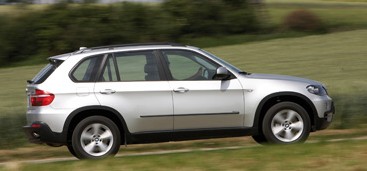



Back Country Journal
Presents:
BMW X5 Review (2008)
| BMW 1 Series | BMW 3 Series | BMW 5 Series | BMW 6 Series | BMW 7 Series |
| BMW Z4 | BMW X3 | BMW X5 | BMW X6 | BMW M Series |

BMW X5 FOR 2008:
The Definitive Sports
Activity Vehicle®
The American-made X5 has
become the
very definition of sporting SUVs that BMW prefers to categorize as the
Sports
Activity Vehicle® or SAV®.
For
2008, the
second-generation X5 enters its sophomore year with revised features to
keep it
abreast of the competition.
Because the
completely-new
2007 X5 was just introduced last year, the 2008 X5 builds upon the
recently-launched technology and performance.
Aside from introducing
7-passenger
seating, which would increase the X5’s practicality without
compromising its established
constellation of attributes, enhanced variability and versatility, such
as
fold-flat rear seats, roomier cargo area and automatic tailgate,
provide even
greater flexibility of usage. It is this
cluster of key attributes that has made SUVs in general so popular. To this day, this incredible combination of
design, utility and performance is what makes the newest X5 a true BMW
with
EfficientDynamics principles instilled in its DNA.
As in previous years, the
X5 offers a
choice of 6-cylinder or V-8 performance: the X5 3.0si and the 4.8i,
both of
them offer performance and excellent efficiency.
The
flagship 4.8i boasts BMW’s all-aluminum
Valvetronic V-8, with 350 horsepower. The
3.0si features BMW’s aluminum/magnesium inline-6 rated at
260-horsepower. Standard equipment on both
models is a 6-speed
STEPTRONIC automatic. BMW&#
8217;s outstanding
xDrive all-wheel-drive system continues, enhanced via a closer link
between the
xDrive electronics and the X5’s Dynamic Stability Control to provide
even
quicker, more accurate response.
The 2008 X5 remains
within the mid-size
class. With an overall length of 191.1
inches, the X5 still tapes in well under such full-size competitors as
the
Lexus GX 470, Cadillac SRX and Range Rover HSE.
The X5’s front suspension
represents a
break from a 45-year-old BMW tradition: It’s a double wishbone
multi-link
design with upper A-arms combined with double-pivot lower links—the
first non-strut
design since 1961. The company’s
departure from its traditional dual-pivot strut front suspension was
dictated
by customers’ increasing expectations for ride and handling. Combined with a longer wheelbase, wider track
and BMW’s revised 4-link Integral rear suspension, the new front design
sets
new standards for on-road ride and handling, as well as improved
all-road
ability. In keeping with its original
mission, the X5’s focus still places more emphasis on pavement
performance, keeping
it well abreast of the competition.
X5 3.0si: The latest
edition of BMW’s trademark inline-6
BMW’s
newest 6-cylinder engine powers the X5 3.0si.
This
aluminum/magnesium composite inline-6 features
the latest engine technology from the company whose middle name is
“Motor.” Almost all vehicle
manufacturers of 6-cylinder engines have
adopted the V-6 format, whose compactness is advantageous in small or
midsize
cars with front-wheel drive. By
contrast, BMW’s inline 6-cylinder engines are brilliant for their
smoothness
and sound, and treasured for these attributes.
An
increase in fuel efficiency and even
tighter control of emissions were also set as goals for this BMW engine
generation.
Key
attributes of this new engine include:
•
Great
power, 260 hp– a very impressive 86.8 hp/liter.
•
Great
torque, 225 lb-ft., strong torque characteristics across the broad
range of
engine speeds. Appropriately for a
substantial SAV®, the new engine attains
its maximum torque at just 2750
rpm.
•
Higher
revving ability. The &#
8220;redline” is
7000 rpm. This allows the X5 driver to
“wind out” the engine for maximum acceleration and exciting sound.
•
Superior
fuel efficiency. Even though
performance is enhanced, EPA mileage ratings are 15 mpg city / 21 mpg
hwy with
the new rating system
The
benefits are all part of a concerted effort to make across-the-board
improvements in engine performance. It
is a fundamental part to BMW’s EfficientDynamics program where you put
less in
and get more out.
Much
of the weight savings in the engine, for instance, is the result of the
engine’s
aluminum/magnesium architecture. The
engine consists of three major components, a magnesium-alloy bedplate,
magnesium-alloy upper
crankcase and a silicon-impregnated (Alusil) aluminum-alloy insert. The first two magnesium castings create an
extremely
rigid, lightweight engine block. The
aluminum-alloy insert provides the actual cylinder bores, much like the
Alusil
crankcase in the X5 4.8i’s V-8 engine.
Other
weight savings come from such items as new, hydro-formed hollow
camshafts,
plastic camshaft cover, thinner exhaust header flanges and an aluminum
cam-chain tensioner.
Obviously,
the adoption of the Valvetronic system also plays an important part in
improving performance and efficiency. Valvetronic
varies valve lift to control engine power, dispensing with a
conventional
throttle. The 2nd-
generation
system includes a number of minor alterations from the original design,
introduced in 2002 in BMW’s V-8 and V-12 engines. More
rigid reciprocating parts allow a 500-rpm
increase in engine redline, while an increase in valve lift improves
top-end
performance. The added rigidity also
permits faster opening of the intake valves, so they are effectively
open
longer. Phasing of the two intake
valves—where one opens sooner than the other&#
8212;improves low-load
efficiency and
cylinder filling.
Complementing
these changes, a new intake system features 3-stage induction, which
spreads
the torque band across a wider rpm range. Likewise,
an altered combustion chamber shape
and a wider range of variability in the double-VANOS valve-timing
system also play a role in the
power and efficiency improvements. Further
modifications, such as all-new engine
electronics and higher fuel-injection pressures, increase the accuracy
of
ignition timing and fuel delivery.
Additional
increases in overall efficiency also add a portion of the N52&#
8217;s
performance
improvement. Seemingly minor items, such
as an electric water pump, variable-volume oil pump and new oil/coolant
heat
exchanger all provide small improvements, making the new inline-
6 more
powerful
and more fuel efficient. All together,
the new engine delivers tangible performance that can be witnessed as
such:
0-60 mph in 7.8 sec.
X5 4.8i: The original
Valvetronic V-8
delivers more power and torque with the same refinement
Under
the X5 4.8i’s hood is a further evolution of this
technologically-advanced and
unique V-8 engine. As such, it continues
BMW’s revolutionary Valvetronic system, which controls engine power by
varying
valve lift instead of relying on a conventional throttle.
With
Valvetronic, engine breathing – air induction – is controlled by
varying valve
lift rather than opening and closing a throttle.
At
minimum lift, the engine is idling or
decelerating; at maximum lift, it delivers full power.
Valvetronic
varies valve lift according to the
driver’s demands for power from the engine.
At
smaller openings (lighter loads), a throttle imposes a restriction that
incoming air must snake around.
This
causes so-called “pumping losses,” which take a greater proportion of
engine
power at lower speeds. By eliminating
the throttle,
Valvetronic essentially does away with these losses.
At
the high end of the powerband, high valve lift contributes to high
“specific
power” (hp/liter). With conventional
valve systems, where valve lift is always the same, there’s a limit to
how high
valve lift can be without degrading low-speed operation. With
Valvetronic, lift is tailored precisely
to operating conditions, and is extra-high at the top end. At the low end, in light-load operation and
during idling, operation is especially smooth because valve lift is low.
Complementing
the Valvetronic system is a dual-stage induction system, which also
helps to
improve the engine’s torque production over a wider rpm range. The high torque peak of 350 lb-ft. occurs over
a range from 3400 to 3800 rpm. Horsepower is also 350 and EPA rates the
X5 4.8i
at 14 mpg city / 19 mpg hwy.
Standard on both models:
an evolved
6-speed STEPTRONIC
This
incredible automatic transmission also benefits from a number of
refinements in
the X5, designed to improve both performance and fuel
efficiency—particularly
in the case where finding the perfect gear for any given road condition
is of
paramount concern in the sporting X5.
The
transmission also features an entirely electric/electronic and similar
in
concept to that of the 7 Series. With the
X5’s console-mounted lever, Reverse, Neutral and Drive appear “inline”
on the
lever’s markings, and are selected by tipping the lever forward or
rearward. Park is engaged via a separate
button at the
lever’s top. The transmission’s three
modes—Drive, Sport and Manual—are selected by toggling the lever left
or right.
In
addition, this new transmission incorporates several new functional
improvements that benefit efficiency and drivability. More
effective internal vibration damping
makes it possible to keep the converter’s lockup engaged more of the
time. This means less slippage and a
fuel-economy
improvement of about 3%. The driver
experiences sharper response to the accelerator pedal. Quicker
shifting response—up to 40% quicker—means
less lag between the time the accelerator pedal is depressed or the
shift lever
is moved and the actual occurrence of a shift.
Once
a shift is initiated, shifting time is
reduced by as much as 50%.
Finally, the
Adaptive shift control, which adjusts shift characteristics to driving
style
and conditions, now features three stages instead of two. This provides finer adaptation to driving
style and conditions.
An additional advantage
of the new
shifter is that it provides significant freedom to
optimize
not only its location on the center console, but its size as well. The result: more space for storage
compartments and large cupholders than would otherwise be possible.
New technology to lower
emissions and
improve fuel economy
The
new X5 also utilizes a number of technologies designed to reduce fuel
consumption, which in turn lowers CO2 emissions, as part of
BMW’s
Efficient Dynamics. The approach was to
consider all aspects of vehicle operation, with particular attention to
reducing friction. The power-
steering
pump is designed to reduce hydraulic pressure in the system during
straight-ahead driving, when no assist is required.
In
addition, the X5’s new Pentosin power-steering
fluid reduces drag in low-temperature operation.
Drag-reducing
efforts in the differentials include
double angular-contact ball bearings, which produce less friction than
conventional bearings.
A stronger body structure
provides the
platform for an all-new suspension
An
intensively engineered body structure heightens the X5’s capabilities
in
virtually all respects with only a relatively modest increase in
weight. Choice of materials, arrangement
and shapes of
reinforcing elements, plus distribution of masses front-to-rear and
bottom-to-top were all considered in the development of a structure
that
improves on the original X5’s remarkable capabilities&#
8212;with respect to
handling
ability, riding comfort and passive safety. Results
include an approximate 15% increase in
torsional rigidity over the previous generation X5.
This
structure makes up the foundation for the X5’s new suspension system,
which
consists of an all-new double wishbone multi-link front suspension. In place of the traditional strut, this new
system has an upper lateral A-arm. The
double-pivot lower arms are retained, so that on each side there are
three
links or arms. While the two lower arms
preserve the advantages of the double-pivot strut system, the new upper
arms
increase the engineers’ ability to optimize the system&#
8217;s handling and
riding
comfort.
The
original system provided a number of benefits, including excellent
steering
feel and control, outstanding straight-line stability, and excellent
steering
return coming out of turns. The design
also
provided generous space for large brakes—a BMW tradition.
The
new system accommodates all these requirements while providing a number
of
benefits of its own. By isolating the
shock from lateral forces, the new system reduces friction and improves
ride
and handling. The anti-roll bars in this
new design mount to the wheel carriers instead of the suspension arms,
which
increases their effectiveness and allows for smaller, lighter weight
bars. Finally, the new design allows more
flexibility
in both shock absorber tuning and suspension geometry.
Enhancing
the front suspension is a variable-ratio power steering unit, which
quickens
steering ratio as the wheels are turned farther from their on-center
position. This fine-tunes steering
response and reduces the amount of
turning required at the steering wheel in tight corners or parking
maneuvers.
Complementing
this front suspension is a revised version of the previous X5&#
8217;s
multi-link rear
suspension. This already sophisticated
system has been adapted to the new X5’s weight, higher performance,
run-flat
tires and BMW’s own evolving standards of ride and handling. The 2008 X5 features aluminum upper and lower
lateral arms and wheel carriers to reduce weight.
More
importantly, the reduction is in unsprung
weight, which reduces inertia so the wheels can respond more accurately
to
uneven road surfaces. Finally, a wide
front and rear track on both the 3.0si and 4.8i improves agility, while
a
longer wheelbase improves ride and increases interior space.
Unique in the segment: Active Steering and
AdaptiveDrive.
The BMW X5 is the first
vehicle in its class to offer
Active Steering as an option. This
advanced system developed by BMW offers the right steering ratio at all
speeds. Up to a speed of approximately
55 mph (90 km/h), steering behavior is more direct, meeting the
requirements of
sporting and active driving. Another
advantage is that the driver only has to turn the steering wheel twice
from
lock to lock. At higher speeds, on the
other hand, the Active Steering transmission is more indirect,
enhancing the
directional stability of the vehicle and, accordingly, driving comfort.
Active Steering, when
ordered, is combined in the new
BMW X5 with Servotronic assist for optimal power steering boost at all
speeds. Active Steering can also help to
stabilize the X5 should the driver experience the onset of oversteer or
understeer in a bend or in particularly demanding brake maneuvers. When applying the brakes on surfaces with
varying frictional coefficients (split-friction braking), for example,
Active
Steering precisely but discreetly countersteers to help the X5 stop in
a sure and
straight line.
Carefully coordinated
interaction of the anti-roll bars
and shock absorbers by way of AdaptiveDrive, part of the optional Sport
Package,
is equally unique in the X5’s segment.
This
combination of Active Roll Stabilization and
Electronic Damping
Control gives the new BMW X5 a standard of handling capability and ride
quality
never seen before in a vehicle of this kind. Using
sensors, AdaptiveDrive constantly monitors and
calculates data on
the road speed of the vehicle, its steering angle, straight-line and
lateral
acceleration, body and wheel acceleration, as well as height levels. Then, based on this information, the system
controls both the swivel motors on the anti-roll bars and the
electromagnetic
shock-absorber valves, controlling body roll and damping as required at
all
times. By simply pressing a button, the
driver can choose either a sporting or a more comfortable basic setting
of
AdaptiveDrive.
World
debut: data transfer via FlexRay.
The FlexRay high-speed
data transmission system is used
for the first time in the industry for fast and reliable coordination
of all
AdaptiveDrive functions. FlexRay has
been enhanced to production standard by a consortium of development
companies
under the leadership of BMW. This system
offers a level of data transfer capacity never seen before. The BMW X5 is the first vehicle in the world
to feature FlexRay technology.
Wheels, tires and brakes:
keeping the
X5 rolling
BMW’s
evolving standards are clearly evident in the wheels, tires and brakes
on the
new X5. All three factors play
significant roles in the ride, handling and safety, so all three
received
significant attention.
The
brakes themselves are evolutionary, with ventilated cast-iron rotors
all around
on both models. Braking power has been
enhanced by large diameter brake rotors:
X5 3.0si: Front:
332mm/13.1in.,
rear: 320mm/12.6in.
X5 4.8i: Front: 348mm/13.7in.;
rear: 345mm/13.6in.
Like
the rest of BMW’s 2008 lineup, the X5’s Dynamic Stability Control
includes a
range of new braking features: Brake Drying, Brake Stand-by, Brake Fade
Compensation and Start-off Assistant. These
are in addition to the previously standard Hill Descent Control and trailer
stabilization, which have
been a part of the X5’s DSC since the vehicle’s introduction.
Maintaining
a BMW tradition, each model offers standard or Sport Package
wheel-and-tire
equipment. Both models come standard
with 18-in. wheels and tires. Sport
Packages for both models include 19-in. wheels with all-season tires. In addition, the X5 4.8i offers 20-in.
equipment as an option in combination with its Sport Package.
Every
’08 X5 also comes with BMW’s run-flat system, which consists of
self-supporting
tires and wheel rims shaped to help keep a flat tire securely in place.
The run-flat system has been further
developed
for the more-severe driving conditions appropriate to the versatile X5.
These tires allow continued driving
at speeds
up to 50 mph on a completely flat tire for up to 90 miles, depending on
the
vehicle load.
Another element
of the new X5 tire/wheel equipment is the
new Tire Pressure Monitoring system. Pressure
in each individual tire is measured directly and monitored via
telemetry. If
pressure in any tire drops by 25% or more, this is indicated to the
driver by a
warning in the instrument cluster.
xDrive: enhancing
X5&#
8217;s
traction and
agility, now even more effectively
Like
other current all-wheel-drive BMWs, the new X5s incorporate BMW’s
advanced
xDrive all-wheel drive and traction system. xDrive
operates as follows:
•
Driving torque is always transmitted
to the rear wheels, and most of the time to all four wheels. Normal torque split is 60% rear/40% front.
•
The portion of torque transmitted to
the front wheels is controlled by a multi-disc clutch that can be fully
open,
fully engaged or at any level of partial engagement in between. The torque split between rear and front wheels
is thus steplessly variable.
•
Engagement pressure on the multi-disc
clutch is directed by an electronic control system in response to
actual road
and driving conditions.
xDrive
does more than optimize traction; it can also enhance both agility and
stability on grippy as well as slippery road surfaces. Via
the same type of logic that DSC employs to
recognize and correct for excessive over- or understeer, xDrive adjusts
the
front/rear torque split to avoid these tendencies.
If
the system senses undesirable oversteer, it
closes the multi-disc clutch completely, sending the maximum possible
torque to
the front wheels. In the case of excess
understeer, xDrive opens the clutch completely, sending no driving
torque to
the front wheels.
The
X5 marks a significant evolution in xDrive capabilities, which has
always
depended upon a networking of Dynamic Stability Control and the xDrive
system. With the overall Integrated
Chassis Management
system, all three control circuits work in parallel.
This
refined interaction achieves even quicker
reactions to changing driving conditions and enhances xDrive&#
8217;s already
outstanding handling dynamics.
Exterior
design & function
The first X5
was a master stroke, creating a whole new vehicle category. As the logical evolution, the current X5 looks
– and is – even more dynamic, more muscular, and more elegant. The X5 combines the muscularity of a fullsize
SAV
® with the
elegance of a luxury sedan, showing that it is truly top-of-the-line.
In its
exterior dimensions, the distance from front wheel center to instrument
panel
is relatively short, moving its optical centerpoint somewhat forward
and thus
accenting its all-wheel drive. Large
wheels and short overhangs emphasize a look (and a reality) of agility.
The interior and long wheelbase both
add
visual stability and heighten the vehicle’s presence.
The X5’s front
view is dominated by BMW’s trademark twin-kidney grille, as well as by
its
headlights, which are self-leveling Xenon Adaptive units. Adaptive headlights “steer&#
8221; the headlights
themselves and operate at all speeds in response to steering angle,
vehicle
speed and yaw rate. Luminous rings in
all four headlights function as parking lights, but can also serve as
daytime
running lights. As a new feature in
addition to Adaptive headlights, cornering lights employ a special
reflector in
each foglight to project an angled beam at low speeds and large
steering
angles.
The rear of
the X5 shows the unique “separation edges” in the new design. Seen in the rear roofline and taillights,
these serve as more than mere aesthetic fillips.
By
smoothing the airflow as it exits, they
improve the X5’s aerodynamics, lowering its CD and thereby
lowering
the X5’s fuel consumption ever so slightly.
It
was BMW’s goal to make the X5 outstanding in
its class, and BMW has achieved this goal, with aerodynamic drag
coefficients
of 0.34 for the 3.0si, 0.35 for the 4.8i.
The exterior
includes other features designed to improve fuel efficiency. These range from the lightweight plastic
fenders and aluminum hood to the slightly flared lower corners of the
front air
dam, which direct air around the front wheels, lowering the drag
produced by
the X5’s massive tires.
Comfort and convenience: the definition of
luxury
The 2008 X5
provides the ideal setting for expanding interior and cargo volume,
with an
array of new amenities and upgrading the general level of technology
enjoyed by
the driver and passengers.
Typical for
BMW SAVs®
is the X5’s “semi-command” driving position, which affords an optimum
view of
the instrument panel and a feeling of control and driving pleasure. The instrument cluster and center-dash
controls and displays are oriented slightly toward the driver, as is
the
electric transmission selector. At the
same level is the iDrive monitor. As
always
in a BMW, controls are grouped logically and conveniently, and are
optimally
accessible to the driver. Those likely
to be operated by the front passenger are just as accessible from that
seat as
well.
Vehicle & Key Memory with enhanced
features
As part of a
longer-term project at BMW to make our vehicles even more adaptable to
customer
preferences, the Vehicle & Key Memory system incorporates an
extensive
array of functions. Settings chosen by a
particular user (identified by his or her remote) during use of the
vehicle are
automatically stored, and then recalled the next time that person uses
the
vehicle. These functions are (*
indicates optional feature):
•
Audio tone
settings and presets
•
Analog or
digital (High Definition
Radio*) choice
•
Language of
displays and voice
functions, display units (metric/English)
•
iDrive
Programmable Memory Keys
•
Climate-control
temperature and
air-distribution settings
•
Seat/steering-wheel/mirror
setting
•
Central-locking
preferences (selective unlocking, automatic locking when vehicle is
underway)
•
Lighting
preferences
•
Head-up
Display settings*
•
Rearview
Camera settings*
Dynamic Cruise Control
Like
conventional cruise control, its operation is controlled from a
combination
stalk, but its function differs from past cruise controls in several
ways. For instance, it can apply brakes
lightly to
maintain set speed, and can limit speed on curves. It
also allows the driver to vary the acceleration
rate to the set speed. Finally, it
provides special functions for downhill driving, such as downshifting
when
appropriate or cutting off fuel flow to maintain speed. It
can even compensate for eventual leaks in
the brakes’ hydraulic system.
Front seating
Standard power
seats include power head-restraint adjustment, making them 10-
way
adjustable. The driver’s-
seat memory
includes steering
wheel and exterior mirror settings.
Sport
seats, of course, are available in the
optional Sport Package. 20-way
multi-contour
front Comfort Seats are also available either as a stand-alone option
or as
part of the optional Active Ventilated Seats Package.
Storage and control
The center
console includes a forward compartment, containing two large
cupholders,
storage, ashtray, cigarette lighter/power outlet, and auxiliary audio
input. The dual left/right armrest lids
can be opened
and closed separately, so one side can function as an armrest while the
other
is open. In addition, the console
contains the iDrive controller, an accessory power outlet in main
storage
compartment, and the button to set and release the new
electro-hydraulic
parking brake.
New glove compartment
A passenger
airbag positioned closer to the windshield allows for a larger glove
compartment. Its 2-door design &#
8211; upper
door opening upward, lower door opening downward – improves access,
while its
position gives users a good view of its contents.
At
the touch of a button to the compartment’s
left, the doors open electrically; they are closed manually. The compartment is locked by the central
locking system.
Simplified iDrive
The standard
iDrive display is in the driver’s primary field of vision, where it can
be
viewed without undue distraction.
The
graphics display has been optimized for 2008 with new colors,
typography,
legibility and contrast under all conceivable light conditions.
Six frequently
used functions can be stored on the Programmable Memory Keys, which are
below
the audio system’s CD drive. The user
can jump to an often-used menu or function by simply pressing the key
where
that function is stored. Additionally,
the last two keys at the right are dedicated AM/FM and Entertainment
Mode
buttons.
Automatic climate control:
dual-zone standard, 4-zone
optional
The
standard X5 climate-control system has separate left/right rotary
controls for
temperature settings, and can also be altered via the iDrive, which can
also be
used to access the Heat at Rest function and “Climatization styles.” A mist sensor, bi-directional solar sensor,
active-charcoal micro-filter and maximum a/c settings are also part of
this
system. Temperature and volume
controlled air vents are standard. In
addition, temperature and air distribution settings are included in
Vehicle
& Key Memory on both the 3.0si and 4.8i.
The
optional 4-zone system, part of the
Rear Climate Package, is described under Packages
& options.
Standard audio system
The standard
audio system for the 2008 X5 includes 12 speakers, along with greater
audio
power, two subwoofers in BMW’s patented underseat positions, and a new
speaker
configuration for optimized sound distribution in the interior. The system also provides a single-disc CD
player, MP3-CD capability, separate audio input, RDS and Weatherband. With BMW Assist, the system also provides
Bluetooth connectivity and audio muting for phone use.
The X5 also
offers a range of audio options, including a Premium Sound Package,
High
Definition Radio, SIRIUS Satellite Radio and a Rear Entertainment
System. These are described under Packages & options.
Upholstery & trim
Leatherette
continues as the standard upholstery in the 3.0si model, and is once
again
available in Sand Beige or Black.
The
The X5’s
interior also includes premium materials on the door panels, dashboard
and
controls. In addition, a variety of trim
materials are available on both the 3.0si and 4.8i, including Dark Burl
Walnut Wood
(standard), Light Poplar Wood, or Dark Bamboo wood.
Rear seating: two or three rows
The X5’s
folding 2nd-row seats contribute to the great variety of people- and
cargo-carrying configurations that are available in this superbly
practical
vehicle. Standard features include
flush-folding seats for a flat cargo floor, with a fold-up center
armrest
incorporating dual cupholders.
Safety
features include head restraints and 3-point safety belts at all three
seating
positions. 3rd-row seating is described
under Packages & options.
Cargo area: increased capacity and
expanded versatility
The X5’s large
in storage capacity has been achieved partly by the X5’s greater
length, partly
by its greater height, and partly by a lower cargo floor made possible
by
omission of space for a full-size spare wheel and tire. Yet
this underfloor space is sufficient to
fold the optional 3rd-row seat flat into the floor.
Safety & security: proven technology
meets innovation
BMW’s
longstanding emphasis on both active and passive safety systems is long
established. Anti-lock brakes, Dynamic
Stability Control and the Head Protection System all illustrate the
emphasis
BMW has placed on the safety of its customers through the years. The 2008 X5 benefits both from proven systems
and the latest safety technology in protecting its occupants.
Many so-called
convenience features—such as Head-up Display, Comfort Access, Automatic
Headlight Control or Park Distance Control—also provide a degree of
safety or
security, even though that might not be their primary function. Some of the active safety features found on the
X5 include:
Automatic Stability Control (ASC). This
term
refers to the fact that when DSC reduces engine power to head off
wheelspin,
its effect is felt at all four wheels because all four are driven.
Automatic Differential Brake (ADB-X). When
any
individual wheel begins to lose traction and reducing engine power
doesn’t
bring it under control, DSC applies that wheel’s brake as necessary to
stop the
wheelspin.
Hill Descent Control (HDC). Helps
the
driver maintain speed and stability
on steep downhill runs.
Trailer stabilization.
Detects
unstable
swinging motion of towed trailer; applies vehicle brakes selectively
and
reduces vehicle speed to less than the critical speed for the trailer’s
swinging.
Enhanced DSC: In addition to
the traditional functions of Dynamic Stability Control, this new system
includes several new features:
•
Dynamic
Traction Control. By raising the
threshold for wheelspin and eliminating brake intervention, DTC can
improve
utilization of available road traction under specific conditions: on
sand,
gravel, deep snow, or packed snow; climbing hills with deep or packed
snow;
when there is deep snow on only one side of the road; when driving with
tire
chains. Activated or de-activated by a
button at dash center.
•
Brake
Fade Compensation. As brake
temperature rises, Brake Fade Compensation automatically increases the
hydraulic pressure in the brake system relative to pedal application,
so the
driver does not have to press harder on the pedal.
•
Brake
Standby. When the driver lifts off
the accelerator pedal abruptly, DSC recognizes that sharp braking may
be about
to occur and applies just enough pressure in the brake system to snug
up the
pads against the rotors. This minimizes
the response time of the braking system.
•
Brake
Drying. Acting on input from the
rain sensor (an element of the rain-sensing windshield wipers), the
pads are
periodically brought up to the rotors to eliminate any film of water
between
pads and rotors.
•
Start-off
Assistant. Keeps the vehicle from
rolling backward for approximately 1.5 seconds after the driver
releases the
brakes when stopped facing uphill.
•
Modulated
ABS function. Thanks to improved
control of the DSC brake valves, the ABS function is smoother than
before. Instead of simply being fully
applied and
released, the application and release of these valves are now modulated.
Passive safety features: much more than
airbags
When many
consumers think about vehicle safety, their first thought is airbags. As critical as these safety features are,
there are far more considerations involved in occupant safety. As the latest BMW SAV®, the 2008 X5 sets a new standard
for the class in this regard, just as it does in active safety.
In developing
the X5 structure, BMW set out to exceed the demands of the world’s most
stringent governmental safety regulations, by minimizing impact loads
on the
occupants and by keeping the passenger space as intact as possible in
many
severe crash scenarios. Among the
specific goals were –
•
Achieving
excellent results in the
Euro-NCAP (New Car Assessment Program) offset frontal crash test, in
which 40%
of the vehicle’s width impacts a fixed barrier at 40 mph.
•
Meeting the
recently introduced U.S.
FMVSS (Federal Motor Vehicle Safety Standard) 301, which specifies a
brutal
50-mph rear-end offset crash. This
impact is taken by 70% of the test vehicle’s width; not only must
stringent
injury criteria be met, but the fuel system must remain free of leaks. With or without the available 3rd-row seating,
the new X5 Series meets this extremely demanding safety standard.
•
Meeting the
also relatively new IIHS
“SUV side-impact” test, in which an impact from a tall vehicle at 50
km/h (31.1
mph) is simulated.
•
Withstanding
the Euro-NCAP
side-impact test, in which a vertical pole is pushed into the vehicle
side at
29 km/h (about 18 mph); this test simulates a vehicle sliding sideways
into a
tree or telephone pole.
Reaching those
goals required diligent efforts in designing the new X5 body structure,
with
particular emphasis on overall structural rigidity of the passenger
compartment;
selection of materials such as aluminum or high-strength steel; energy
absorption and deformation paths; and component placement&#
8212;including the
engine
and transmission addition, specific considerations and testing included
both 5-
and 7-passenger configurations of the X5. The
results affected everything from the
overall body structure to the design of an all-new steering column.
Rollover Sensor
The system
featured on the X5 is an outgrowth of BMW’s work in designing rollover
protection
systems for its convertibles. In the X5,
the Rollover Sensor is networked with the vehicle’s Dynamic Stability
Control,
which delivers data on lateral acceleration (“cornering&#
8221;) and any
possible
skidding. The Rollover Sensor measures
the body’s angle along its longitudinal axis, and the rate at which
that angle
is changing. Additionally, acceleration
data in two directions are measured to test the plausibility of a
rollover. On the basis of these
measurements, an
algorithm determines if the vehicle is about to roll over. If this is the case, the front and rear Head
Protection System is deployed on both sides, and all safety belts with
tensioners are tensioned.
Safety belts & airbags
As with all
BMWs, 3-point safety belts are supplied for all seating positions,
including
the optional 3rd row.
Likewise,
all positions include force
limiters, as well as adjustable head restraints.
Front
seats also include belt tensioners,
along with dual-stage front airbags and seat-mounted (instead of the
previous
door-mounted) side-impact airbags. BMW’s
curtain-type Head Protection System covers front and 2nd-row seats. Front airbags are newly configured to optimize
their 2-stage, accident-severity-dependent deployment characteristics,
inflated
shape, and interaction with surrounding surfaces and components. The X5’s new body structure makes the
previously available rear side-impact airbags unnecessary.
Packages & options: new content and
packages complement
familiar features
Active Ventilated Seats Package: Includes
20-way adjustable Multi-contour front seats with Active Comfort and
ventilation
features.
Cold Weather Package: Includes
retractable headlight washers, heated steering wheel, heated front
seats, ski
bag w/rear-seat pass-through.
Premium Package: Both
models include 4-way power lumbar support on the front seats;
Auto-dimming
interior and exterior mirrors; digital compass; power-fold exterior
mirrors;
BMW Universal Transceiver; Ambiance Lighting package; Storage package;
BMW
Assist with a 4-year subscription and Bluetooth cellphone interface. The 3.0si also adds a choice of
Premium Sound Package: Includes Premium
sound system with 16 speakers and glovebox-mounted 6-disc CD/DVD
changer with
MP3 capability.
Rear Climate Package: Includes
4-zone climate control, manual rear sunshades and Privacy Glass.
Sport Package: Includes
19-inch wheels, Sport seats, Shadowline exterior trim, Sport steering
wheel and
anthracite-color headliner; Adaptive Drive: Active Roll Stabilization
and
Electronic Damping Control. With the
Sport Package, the 4.8i adds the separate option of 20-inch wheels with
performance tires. Comfort Seats is an additional option here for both
models.
Technology Package: Includes Park
Distance
Control, Rearview camera,
Navigation with Voice Command and Real Time Traffic Information with
dynamic
rerouting.
Factory options:
Active Steering: A first with
any all-wheel-drive BMW, Active Steering varies steering ratio widely
to achieve
amazing agility at lower speeds while retaining stability at higher
speeds. The system includes Servotronic
vehicle-speed-sensitive power assist. Sport
Package is required.
Automatic Tailgate: This allows
the X5 owner to open or close the rear tailgate automatically with
motorized
assist for greater convenience.
Comfort Access: Allows the
owner to enter and start the X5 without removing the remote from his or
her
pocket.
Aluminum running boards: Dresses up
the exterior and enables easier entry and exit from the vehicle.
Multi-contour Front Comfort Seats: Available
as a stand-alone option or as part of the Active Ventilated Seats
Package,
these seats offer 20-way adjustability.
Heated front seats: Available as a
stand-alone option or as part of the Cold Weather Package, these front
seats
offer 4 heating zones, rapid heating and 3-stage heating.
Rear-seat heating: Provides
3-stage heating for the 2nd-row seats.
Requires
Cold Weather Package or heated front
seats.
3rd-row seating : Adds 3rd
seating row to accommodate two additional passengers.
The 3rd-row
seats fold flush into floor, and the option includes adjustable 2nd-
row
seating
with flush-fold function and easy-entry to 3rd row.
Both rows fold to provide a completely flat
cargo floor. On 3.0si, the option also
includes the self-leveling rear suspension, which is standard on the
4.8i.
Park Distance Control: Available as a
stand-alone option or as part of the Technology Package, Park Distance
Control
adds a visual display in the iDrive monitor.
BMW On-board Navigation System: Available as a
stand-alone option or as part of the Technology Package,
Navigation system includes expanded iDrive, Real Time Traffic
Information with
dynamic rerouting and 8.8-inch screen.
Head-up Display: Driver can read key
information with minimal
diversion. Includes variable brightness
and positioning; can be turned off or on as desired.
High Definition Radio: As
the first manufacturer to offer this feature, BMW provides
exceptional
digital audio reproduction for both AM and FM stations.
Multicasting reception capability allows access to additional
radio
programming as well. No subscription fee
is needed.
Sirius Satellite Radio: Integrated
into vehicle audio system, Sirius provides 120 stations with
uninterrupted
programming.
iPod/USB
Adapter: Enables an MP3 player to be played through the vehicle’s
audio system. This option fully integrates
an iPod’s
functionality into the audio system and multifunction steering wheel
and
enables non-iPod MP3 players and thumbdrives to be used as well.
Rear-seat Entertainment System: Includes
an 8.0-inch rear TFT screen with controller, DVD player and infra-
red
wireless
headphones. Also includes wireless remote
control and wireless headphones.
BMW Ultimate Service TM :
providing owners with
incredible value and peace of mind
BMW announces
BMW
Ultimate
ServiceTM ,
a suite of services that includes the BMW Maintenance Program (formerly
called
Full Maintenance), Roadside Assistance, the New Vehicle Limited
Warranty and
BMW AssistTM with
TeleService.
BMW Ultimate Service TM includes:
The BMW Maintenance
Program is
the only no-cost maintenance program in the industry that
covers wear and tear items like brake pads and rotors for 4 years or
50,000
miles, whichever comes first. BMW owners
pay nothing for all scheduled inspections, oil changes, brake pads,
wiper blade
inserts and other wear-and-tear items.
BMW Roadside Assistance is
one of the industry’s most comprehensive plans available. Not only is it no-charge for the
first four
years, but there is no mileage limit.
BMW
drivers enjoy the assurance of on-the-road help 24
hours a day, 7
days a week, anywhere in the
BMW New Vehicle Limited
Warranty:
All 2008 BMW passenger vehicles are covered by
BMW’s excellent Limited Warranty, which includes:
•
New-vehicle
warranty – 4-year/50,000-mile coverage of the vehicle.
•
Rust-perforation
warranty – 12-year/unlimited-mileage coverage.
BMW AssistTM provides
the driver with services that enhance on-the-road security and
convenience, for
added peace of mind. The BMW
AssistTM Safety
Plan is
standard on all 5, 6, and 7 Series models, including M5 and M6, and is
included
in the Premium Package or available as a stand-alone option on all
other
models. BMW is the only manufacturer
that will offer this service for 4 years
at no additional cost. Most other
manufacturers cover only the first year of service.
The in-vehicle
equipment for BMW AssistTM includes
GPS technology and hands-free
communication functions accessed via buttons in the overhead or center
console. Vehicle occupants may request
emergency or other services simply by pressing a button; the BMW AssistTM system
then transmits the location and vehicle
information to the
TeleService 8 automatically
notifies the BMW center when a vehicle will need service.
This feature allows the Service Advisor to
proactively set up a customer appointment and have the needed parts
ready.
BMW Assist TM subscribers
can
also enroll in the BMW AssistTM Convenience Plan (available at
an additional cost of $199 per year) to
avail themselves of many BMW AssistTM Concierge
services, from travel planning to dining
reservations, shopping assistance and event tickets, as well as receive
directions, and traffic and weather information. On
many models produced September 2006 and later, a selected
destination and its phone number can be sent directly to the on-
board
navigation system and Bluetooth ® &#
8211;linked
mobile phone, after a push of the new Concierge button.
The
Convenience Plan also includes Critical Calling, a new service that
connects
the driver in case their mobile phone
is not in the vehicle or its battery is
discharged. After pushing the SOS
button, a BMW AssistTM response specialist
will link the driver to his requested party for up to five minutes and
for up
to four events per year.
As before, the BMW AssistTM system
includes Bluetooth® hands-free phone
connectivity with hands-free
phonebook access and dialing by name or number via the steering wheel
controls. Use of this feature requires a
customer-provided compatible Bluetooth® mobile phone.
The new
BMW X5: Groundbreaking concept is again
the new benchmark
Innovative technology, a
premium and luxurious
ambience, powerful elegance in body design and superb driving dynamics
make the
BMW X5 a genuine exception in its segment.
The
new model continues the tradition of its predecessor,
the world’s
first Sports Activity Vehicle®,
which set the foundation for a brand-new class of vehicles.
The engineers and
development specialists creating the
new BMW X5 have succeeded once again in crafting a truly unique vehicle
for the
market. In a segment now subject to
fierce competition, the new BMW X5 sets the standard yet again in
driving
dynamics and agility. No other vehicle
combines the qualities so typical of a BMW with the features of a truly
versatile SAV® full of style and
presence.
Given all these
qualities, the new BMW X5 meets all the
demands and requirements of the discerning motorist who, through the
choice of
his or her vehicle, wishes to express his personal and independent
lifestyle
and at the same time enjoy a new driving experience in a new dimension.
SAV and Sports Activity
Vehicle are the
registered trademarks for BMW light trucks.
Performance with a conscience
BMW
strives to produce its motor vehicles and other products with the
utmost
attention to environmental compatibility and protection.
Integrated into the design and development of
BMW automobiles are such criteria as resource efficiency and emission
control
in production; environmentally responsible selection of materials;
recyclability during production and within the vehicle; elimination of
CFCs and
hazardous materials in production; and continuing research into
environmentally
friendly automotive power sources. Tangible
results of these efforts include the recycling of bumper cladding into
other
vehicle components; water-based paint color coats and powder clear
coats;
near-future availability of hydrogen-powered models; and various design
and
engineering elements that help make BMWs easier to dismantle at the end
of
their service life.
BMW Group In
BMW of North America, LLC
has been present in the United
States since 1975. ROLLS-ROYCE Motor
Cars NA, LLC began distributing vehicles in 2003.
The
BMW Group in the United States has grown
to include marketing, sales, and financial service organizations for
the BMW
brand, the MINI brand, and the ROLLS-ROYCE brand of Motor Cars;
DesignworksUSA,
an industrial design firm in California; a technology office in Silicon
Valley
and various other operations throughout the country.
BMW Manufacturing Co., LLC in South Carolina
is part of BMW Group’s global manufacturing network and is the
exclusive manufacturing
plant for all Z4 Roadster and X5 Sports Activity Vehicles®. The BMW Group sales organization is
represented in the U.S. through networks of 338 BMW passenger car
centers, 335
BMW Sports Activity Vehicle® centers, 142 BMW motorcycle retailers,
82 MINI
passenger car dealers, and 30 ROLLS-ROYCE Motor Car dealers. BMW (US) Holding Corp., the BMW Group’s sales
headquarters for North, Central and South America, is located in
Woodcliff
Lake, New Jersey.
Information
about BMW Group products is available to consumers via the Internet at:































